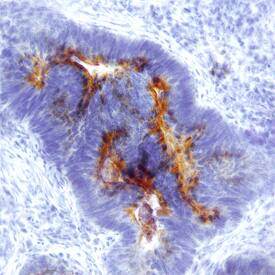Human EphB2 Antibody
Human EphB2 Antibody Summary
Val19-Leu543 (predicted)
Accession # P29323
Applications
Please Note: Optimal dilutions should be determined by each laboratory for each application. General Protocols are available in the Technical Information section on our website.
Scientific Data
 View Larger
View Larger
EphB2 in Human Colon. EphB2 was detected in immersion fixed paraffin-embedded sections of human colon using Human EphB2 Monoclonal Antibody (Catalog # MAB51891) at 15 µg/mL overnight at 4 °C. Before incubation with the primary antibody, tissue was subjected to heat-induced epitope retrieval using Antigen Retrieval Reagent-Basic (Catalog # CTS013). Tissue was stained using the Anti-Mouse HRP-DAB Cell & Tissue Staining Kit (brown; Catalog # CTS002) and counterstained with hematoxylin (blue). View our protocol for Chromogenic IHC Staining of Paraffin-embedded Tissue Sections.
Reconstitution Calculator
Preparation and Storage
- 12 months from date of receipt, -20 to -70 °C as supplied.
- 1 month, 2 to 8 °C under sterile conditions after reconstitution.
- 6 months, -20 to -70 °C under sterile conditions after reconstitution.
Background: EphB2
EphB2, also known as Cek5, Nuk, Erk, Qek5, Tyro5, Sek3, Hek5, and Drt, is a 125 kDa member of the transmembrane Eph receptor tyrosine kinase family that binds members of the Ephrin family on adjacent cells. The interaction triggers forward signaling in the receptor-expressing cells through the Eph receptor and reverse signaling in the ligand-expressing cells through Ephrin (1, 2). Human EphB2 cDNA encodes a 1055 amino acid (aa) precursor, which includes an 18 aa signal sequence, a 525 aa extracellular domain (ECD), a 21 aa transmembrane segment, and a 491 aa cytoplasmic domain. The ECD contains a cysteine-rich region followed by two fibronectin type III domains. The cytoplasmic domain contains the tyrosine kinase domain, a sterile alpha motif (SAM), and a PDZ binding motif (3). Human EphB2 shares 99% aa sequence identity with mouse and rat EphB2 within the ECD region. A short isoform that lacks 70 aa at the C-terminus has also been reported (4). Hippocampal neurons can release vesicles containing full length EphB2, and these are taken up by neighboring glial cells (5). EphB2 is expressed on both sides of the neuronal synapse. It controls axon guidance across the embryonic midline, promotes a neuronal fate from neural precursors, and regulates NMDA receptor activity (6 10). EphB2 interaction with Ephrin A5 promotes axonal growth cone collapse, while its interaction with Ephrin B ligands is required for inner ear, renal, urorectal, and vascular development (6, 11 15). Signaling in Ephrin-expressing cells through EphB2-Ephrin complex requires proteolytic cleavage of EphB2 that releases its extracellular domain (16). Following the shedding of the extracellular domain of EphB2, the cytoplasmic domain of EphB2 is released from the plasma membrane by the presenilin-dependent gamma -secretase activity to initiate a signaling cascade in the EphB2-expressing cells (16). Aberrant EphB2 expression and activity are implicated in the progression of several cancers (17).
-
Pasquale, E.B. (2008) Cell 133:38.
-
Merlos-Suarez, A. and E. Batlle (2008) Curr. Opin. Cell Biol. 20:194.
-
Fox, G.M. et al. (1995) Oncogene 10:897.
-
Tang, X.X. et al. (1998) Oncogene, 17:521.
-
Lauterbach, J. and R. Klein (2006) J. Neurosci. 26:11575.
-
Cowan C.A. et al. (2000) Neuron 26:417.
-
Bouvier, D. et al. (2008) J. Neurochem. 106:682.
-
Cramer, K.S. et al. (2006) Dev. Biol. 295:76.
-
Katakowski, M. et al. (2005) Neurosci. Lett. 385:204.
-
Henderson, J.T. et al. (2001) Neuron 32:1041.
-
Himanen, J.-P. et al. (2004) Nat. Neurosci. 7:501.
-
Dravis, C. et al. (2007) Hear. Res. 223:93.
-
Dravis, C. et al. (2004) Dev. Biol. 271:272.
-
Ogawa, K. et al. (2006) J. Cell Sci. 119:559.
-
Salvucci, O. et al. (2006) Blood 108:2914.
-
Litterst, C. et al. (2007) J. Biol. Chem. 282:16155.
-
Castano, J. et al. (2008) Histol. Histopathol. 23:1011.
Product Datasheets
FAQs
No product specific FAQs exist for this product, however you may
View all Antibody FAQsReviews for Human EphB2 Antibody
There are currently no reviews for this product. Be the first to review Human EphB2 Antibody and earn rewards!
Have you used Human EphB2 Antibody?
Submit a review and receive an Amazon gift card.
$25/€18/£15/$25CAN/¥75 Yuan/¥2500 Yen for a review with an image
$10/€7/£6/$10 CAD/¥70 Yuan/¥1110 Yen for a review without an image

